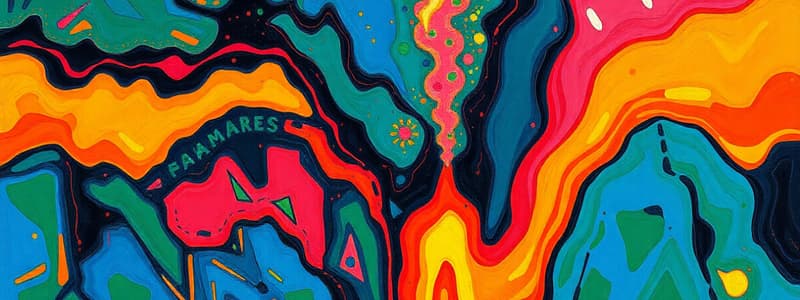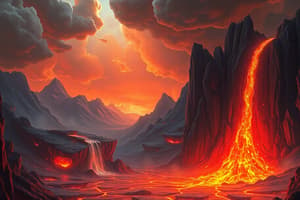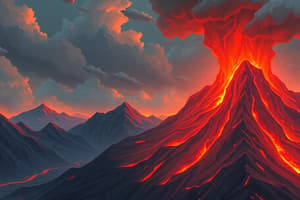Podcast
Questions and Answers
What is magma primarily composed of?
What is magma primarily composed of?
- Solid rocks
- Frozen minerals
- Molten rock (correct)
- Gaseous substances
What is the term for magma that has reached the Earth's surface?
What is the term for magma that has reached the Earth's surface?
- Magma
- Lava (correct)
- Viscous rock
- Solidified magma
Which factor primarily influences the viscosity of magma?
Which factor primarily influences the viscosity of magma?
- Silica content (correct)
- Presence of minerals
- Location of formation
- Temperature only
What is the process called when pressure decreases but temperature remains constant, causing rocks to melt?
What is the process called when pressure decreases but temperature remains constant, causing rocks to melt?
What happens to the viscosity of lava as its temperature decreases?
What happens to the viscosity of lava as its temperature decreases?
What is the term for the melting temperature of a rock, which is lower than that of its constituent minerals?
What is the term for the melting temperature of a rock, which is lower than that of its constituent minerals?
What is partial melting?
What is partial melting?
What primarily causes magma to be formed through heat transfer melting?
What primarily causes magma to be formed through heat transfer melting?
What is the term for the process when magma is separated from rock that has not undergone complete melting?
What is the term for the process when magma is separated from rock that has not undergone complete melting?
Which type of eruption is characterized by the flow of lava and formation of lava fountains?
Which type of eruption is characterized by the flow of lava and formation of lava fountains?
What describes a shield volcano?
What describes a shield volcano?
Which of the following processes transforms a grain of one mineral into a grain of another with the same composition?
Which of the following processes transforms a grain of one mineral into a grain of another with the same composition?
What is the characteristic of cinder cone volcanoes?
What is the characteristic of cinder cone volcanoes?
What is the process called when a rock changes its form without undergoing melting?
What is the process called when a rock changes its form without undergoing melting?
Which type of lava is associated with explosive eruptions?
Which type of lava is associated with explosive eruptions?
What does neocrystallization refer to?
What does neocrystallization refer to?
Flashcards
Magma
Magma
Molten rock found beneath Earth's surface
Lava
Lava
Magma that erupts onto Earth's surface
Viscosity
Viscosity
Resistance to flow of a liquid
Partial Melting
Partial Melting
Signup and view all the flashcards
Decompression Melting
Decompression Melting
Signup and view all the flashcards
Flux Melting
Flux Melting
Signup and view all the flashcards
Heat Transfer Melting
Heat Transfer Melting
Signup and view all the flashcards
Eutectic Temperature
Eutectic Temperature
Signup and view all the flashcards
Fractionation
Fractionation
Signup and view all the flashcards
Volcano
Volcano
Signup and view all the flashcards
Volcanic Eruption
Volcanic Eruption
Signup and view all the flashcards
Effusive Eruption
Effusive Eruption
Signup and view all the flashcards
Explosive Eruption
Explosive Eruption
Signup and view all the flashcards
Metamorphism
Metamorphism
Signup and view all the flashcards
Recrystallization
Recrystallization
Signup and view all the flashcards
Neocrystallization
Neocrystallization
Signup and view all the flashcards
Study Notes
Magma and Volcanism
- Earth's internal heat drives geological processes, including volcanism and plate tectonics
- Rocks on Earth's surface are typically solid, but rocks exist in a liquid state deep within the Earth
- Molten rocks beneath the Earth's surface are called magma
- Magma is less dense than surrounding solid rock, enabling it to rise towards the surface
- When magma reaches the surface, it is called lava
- Magma's ability to flow is called viscosity
- Viscosity is impacted by silica content; higher silica equals higher viscosity
- Higher temperature magma has lower viscosity, flowing more readily
- Magmas form deep inside the crust and upper mantle when conditions are right for pre-existing solid rock to melt
- Three ways magma is generated:
- Decompression melting: Temperature stays the same, but pressure decreases
- Flux melting: Addition of volatile (gaseous) substances to hot solid rock
- Heat transfer melting: Very hot magma brings additional heat to surrounding rock, causing it to melt
Formation of Magma
- Rocks melt over a range of temperatures
- The melting temperature of rock (eutectic temperature) is lower than its constituent minerals
- Partial melting occurs when only certain minerals in a rock melt
- The rock completely melts when temperature reaches a sufficient level
Fractionation
- If magma separates from rock that hasn't fully melted, the magma will contain components that melted at lower temperatures, while the remaining rock will contain components with higher melting temperatures
Volcano
- Volcanoes are visible manifestations of rock formation
- A volcano's vent acts as a conduit for lava/molten rock to reach the surface
- The funnel-shaped depression where materials are ejected is called a crater
- Eruptions are events when lava spews out of a volcano
- Two types of eruptions:
- Effusive: Dominated by lava flow and lava fountains
- Explosive: Ejects ash and pyroclastic fragments, forming ash clouds
- Lava composition impacts eruption type
- Low silica = less viscous, effusive eruptions
- High silica = more viscous, explosive eruptions
Three Types of Volcanoes
- Shield volcanoes: Broad, dome-shaped with gentle slopes, covering wide areas
- Cinder cone volcanoes: Conical hills composed of granular materials formed by lava fountains erupted from a single vent
- Stratovolcanoes (composite volcanoes): Steep-sided, cone-shaped; formed by viscous, sticky lava
Metamorphism
- Metamorphism: The process where a rock's form changes into a new one without melting
- Metamorphism implies change occurs in a solid state.
- Metamorphism involves processes over thousands to millions of years
- Three main processes:
- Recrystallization: Changes in shape and size of minerals without changing the mineral's identity
- Phase change: Transformation of one mineral grain into another with the same composition but different crystal structure (e.g., coesite from quartz)
- Neocrystallization: Growth of new minerals differing from those in the protolith (original rock)
- Pressure solution: Mineral grains dissolve under pressure in the presence of water
- Plastic deformation: Mineral grains become flattened or elongated without altering composition or structure due to high temperature and pressure
Causes of Metamorphism
- High temperatures cause atoms to vibrate rapidly, stretching and bending chemical bonds
- Bonds breaking allows atoms to detach and form new bonds with other atoms, leading to rearrangement within the mineral or migration into other minerals
- Recrystallization and neocrystallization are consequences of atomic rearrangement
Types of Metamorphism
- Contact metamorphism: Rock minerals and textures changed by heat due to contact with magma
- Regional metamorphism: Rock minerals and textures changed by pressure over a wide area or region (e.g., from converging tectonic plates)
Studying That Suits You
Use AI to generate personalized quizzes and flashcards to suit your learning preferences.




